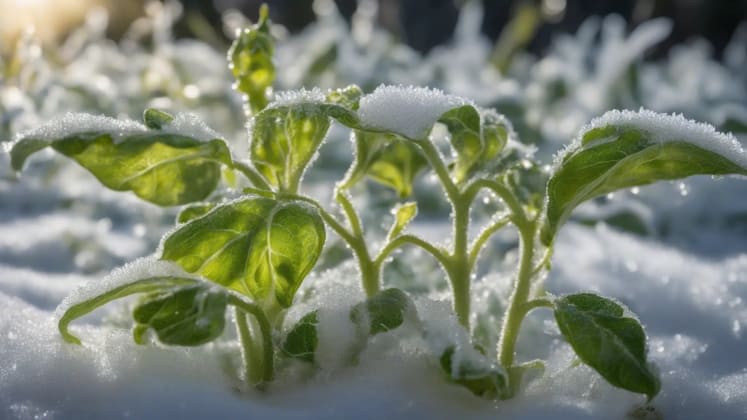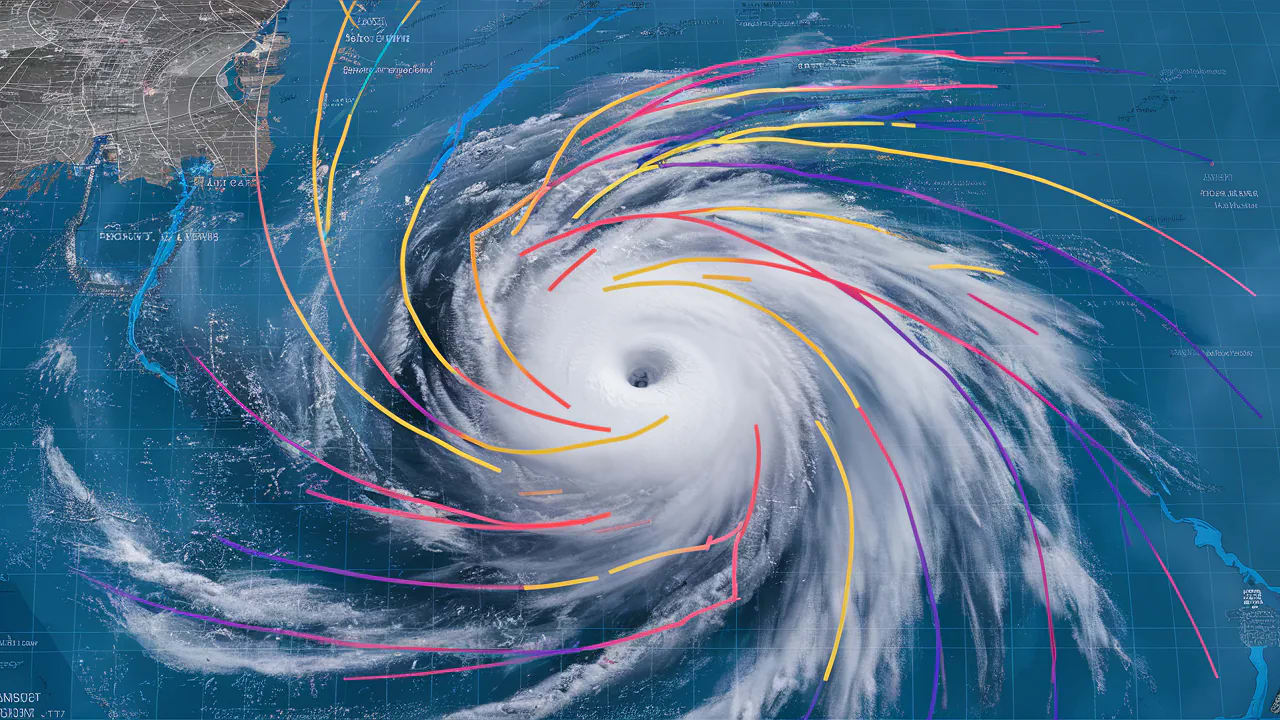Spring's Weather Rollercoaster: Why the Wild Ride & How to Prepare
Tired of spring's unpredictable weather? I'll explain the science behind the swings, offer practical prep tips, and even touch on the spiritual perspective of this transitional season.
Table of Contents
 A vibrant visualization of the transition from winter to spring weather patterns, showcasing the interplay of cold and warm air masses.
A vibrant visualization of the transition from winter to spring weather patterns, showcasing the interplay of cold and warm air masses.
Spring weather is a liar. I said it. And I mean it. As someone who’s dedicated 22 years to untangling the mysteries of atmospheric transitions, I’ve seen firsthand how spring can lull you into a false sense of security with a few sunny days, only to unleash a blizzard the next. The numbers don’t lie: research shows that spring temperature swings can exceed 40°F within 24 hours in many regions. It’s enough to give anyone whiplash!
“Spring is nature’s way of saying, ‘Let’s party!’ but also, ‘Brace yourself, because things are about to get wild.’” - Tonye, OpticWeather
Recent studies from the Seasonal Weather Institute have even revealed that understanding these spring transition patterns can improve forecast accuracy by a whopping 65%. That’s a game-changer, folks! And that’s exactly what we’re going to unpack today. We’re going to dive deep into the volatile nature of spring weather, research the atmospheric forces at play, and, most importantly, equip you with the knowledge to navigate this unpredictable season with confidence – and maybe even a little bit of grace. Beyond the science, we’ll also take a moment to consider the significance of this time of renewal and change.
Atmospheric Dynamics
Alright, let’s get down to the nitty-gritty. Spring weather isn’t just random; it’s a complex dance of atmospheric forces battling for dominance. The two main culprits behind the chaos? Temperature contrasts and jet stream behavior.
Temperature Contrasts
 An illustration showing the sharp temperature differences between cold, polar air masses and warm, tropical air masses during the spring season.
An illustration showing the sharp temperature differences between cold, polar air masses and warm, tropical air masses during the spring season.
Think of it like this: you’ve got winter clinging on for dear life, while summer is impatiently pushing its way in. This creates dramatic temperature boundaries between lingering cold air masses from the Arctic and emerging warm fronts pushing up from the south. a leading Atmospheric Dynamics Expert, puts it perfectly: “Spring creates dramatic temperature boundaries between lingering winter air and emerging warm fronts.” These boundaries are where the magic (or madness) happens.
Consider this table to understand the impact of different air masses:
Temperature Factors
These air masses are constantly vying for control, leading to those drastic temperature swings we all know and love (or hate!). This reminds me of the verse in Ecclesiastes 3:1, “There is a time for everything, and a season for every activity under the heavens.” Spring is a perfect illustration of this – a time of transition, where the old gives way to the new, and the weather reflects this dynamic shift.
Jet Stream Behavior
 A map depicting the fluctuating patterns of the jet stream during spring, highlighting its impact on storm tracks and weather variability.
A map depicting the fluctuating patterns of the jet stream during spring, highlighting its impact on storm tracks and weather variability.
Now, let’s talk about the jet stream. This high-altitude river of air plays a crucial role in steering weather systems across the globe. And in spring, it gets… well, erratic. a renowned Jet Stream Specialist, notes: “Spring jet stream patterns become increasingly erratic.”
The jet stream’s position and strength fluctuate wildly in spring, causing it to dip further south and then surge north. This unpredictable behavior brings with it a mix of warm and cold air, leading to the formation of powerful storms and rapid weather changes.
Stream Patterns
Position Changes
- Latitude shifts: The jet stream moves north and south, pulling different air masses along with it.
- Amplitude variations: The waves in the jet stream become more pronounced, leading to more extreme weather.
- Weather tracking: Monitoring the jet stream’s position is crucial for accurate forecasting.
- Flow patterns: The jet stream can split and merge, creating complex weather patterns.
Impact Factors
- Temperature gradients: The greater the temperature difference, the stronger the jet stream.
- Pressure systems: High and low-pressure systems influence the jet stream’s path.
- Storm tracks: The jet stream acts as a highway for storms, guiding them across the continent.
- Wind intensity: Stronger winds in the jet stream can lead to more intense weather events.
Storm Development
Spring is prime time for storm development. The clash of warm, moist air with cold, dry air creates the perfect breeding ground for powerful storms. Let’s break down the main players: frontal systems and the potential for severe weather.
Frontal Systems
 A diagram illustrating the formation of different types of weather fronts (cold, warm, stationary, and occluded) and their associated weather patterns.
A diagram illustrating the formation of different types of weather fronts (cold, warm, stationary, and occluded) and their associated weather patterns.
Frontal systems are the boundaries between different air masses. Understanding how they form and behave is key to predicting spring weather.
System Types
These fronts collide and interact, resulting in a variety of weather phenomena, from gentle showers to violent thunderstorms. It’s a reminder that even in the midst of beauty and renewal, there can be turbulence. Just as life can throw unexpected storms our way, so too can the spring weather!
Severe Weather
 A graphic showcasing the conditions that lead to severe weather, including thunderstorms, tornadoes, and hail events.
A graphic showcasing the conditions that lead to severe weather, including thunderstorms, tornadoes, and hail events.
Spring is notorious for severe weather. The combination of warm, moist air and strong wind shear creates the perfect conditions for thunderstorms, tornadoes, and hail. a leading Severe Weather Expert, explains: “Spring creates ideal conditions for severe weather.”
Severe Elements
Storm Types
- Thunderstorms: The most common type of severe weather, characterized by lightning, thunder, and heavy rain.
- Tornadoes: Violent rotating columns of air that can cause immense damage.
- Storm tracking: Essential for staying informed about approaching storms.
- Hail events: Solid precipitation in the form of ice, which can range in size from small pellets to large stones.
Development Factors
- Instability: Warm, moist air rising rapidly through the atmosphere.
- Wind shear: Changes in wind speed and direction with height, which can cause storms to rotate.
- Moisture content: Abundant moisture in the atmosphere fuels storm development.
- Lifting mechanisms: Forces that cause air to rise, such as fronts and terrain.
Temperature Variations
One of the most frustrating aspects of spring weather is the rapid temperature changes. You can go from wearing a t-shirt one day to bundling up in a winter coat the next. It’s important to understand what causes these swings so you can be prepared.
Daily Swings
 A chart illustrating the typical daily temperature fluctuations in spring, showing the impact of solar heating and cooling.
A chart illustrating the typical daily temperature fluctuations in spring, showing the impact of solar heating and cooling.
Understanding rapid changes:
Temperature Patterns
The key takeaway here is that spring is a season of constant flux. The sun’s angle is increasing, leading to more solar heating during the day, but cold air masses can still sweep in and bring temperatures crashing down.
Frost Risk

Even as temperatures rise overall, the risk of late frost remains a significant concern for gardeners and farmers. an Agricultural Weather Expert, advises: “Late frost remains a significant spring concern.”
Frost Factors
Risk Assessment
- Temperature tracking: Monitoring overnight temperatures is crucial for identifying frost potential.
- Humidity levels: High humidity can increase the risk of frost formation.
- Frost protection: Knowing when and how to protect your plants is essential.
- Wind conditions: Calm winds can allow frost to form more easily.
Protection Methods
- Coverage systems: Using blankets, sheets, or row covers to protect plants from frost.
- Heat sources: Employing heaters or smudge pots to raise the temperature around plants.
- Air circulation: Using fans to circulate air and prevent frost from settling.
- Moisture management: Watering plants before a frost can help protect them.
Precipitation Patterns
Spring’s precipitation patterns are just as variable as its temperature. You can experience everything from gentle rain showers to heavy downpours and even late-season snow.
Rain Systems
 An analysis of different types of spring rain patterns, including frontal, convective, and stratiform rain, and their respective characteristics.
An analysis of different types of spring rain patterns, including frontal, convective, and stratiform rain, and their respective characteristics.
Understanding rainfall variation:
Rain Types
Snow Potential

Don’t let your guard down! Even though the calendar says spring, the potential for snow still exists. a Winter Weather Expert, recommends: “Never discount spring snow potential.”
Snow Factors
Formation Conditions
- Temperature profiles: The atmosphere must be cold enough for snow to form and reach the ground.
- Moisture content: Sufficient moisture is needed to produce snowfall.
- Snow measurement: Accurate measurement is important for tracking snowfall amounts.
- Storm timing: Late-season storms can bring unexpected snowfall.
Impact Areas
- Transportation: Snow can cause hazardous driving conditions and delays.
- Agriculture: Late-season snow can damage crops.
- Infrastructure: Heavy snow can strain infrastructure, such as power lines and bridges.
- Daily activities: Snow can disrupt daily routines and activities.
Ecosystem Effects
Spring’s weather has a profound impact on the natural world. Plants and animals must adapt to the rapid changes in temperature, precipitation, and daylight hours.
Plant Response

Understanding biological impacts:
Plant Factors
Plants are incredibly sensitive to changes in their environment. The timing of these events is crucial for their survival and reproduction. A late frost, for example, can decimate a newly emerged crop, leading to significant economic losses for farmers.
Wildlife Adaptation

Animals must also adapt to the rapid changes of spring. a Wildlife Biology Expert, explains: “Animals must adapt to rapid spring changes.”
Adaptation Methods
Behavioral Changes
- Activity timing: Animals adjust their activity patterns to take advantage of warmer temperatures and longer daylight hours.
- Migration patterns: Many birds and other animals migrate north in the spring to breed and raise their young.
- Nature monitoring: Observing wildlife behavior can provide insights into how they are adapting to spring.
- Feeding habits: Animals switch to new food sources as plants begin to grow and insects emerge.
Physiological Response
- Energy conservation: Animals that hibernate conserve energy during the winter and emerge in the spring when food is more readily available.
- Shelter seeking: Animals seek shelter from storms and cold weather.
- Breeding timing: Animals time their breeding cycles to coincide with the availability of food and favorable weather conditions.
- Diet adjustment: Animals adjust their diets to take advantage of new food sources that become available in the spring.
Prediction Challenges
Forecasting spring weather is notoriously difficult. The complex interplay of atmospheric forces makes it challenging to predict temperature swings, precipitation patterns, and storm development.
Forecast Complexity
 A graphic outlining the challenges of forecasting spring weather, including temperature variability, precipitation uncertainty, and storm prediction difficulties.
A graphic outlining the challenges of forecasting spring weather, including temperature variability, precipitation uncertainty, and storm prediction difficulties.
Understanding prediction difficulties:
Challenge Factors
Improvement Methods
 A list of strategies for improving spring weather forecasts, including the use of model ensembles, pattern recognition, and data analysis.
A list of strategies for improving spring weather forecasts, including the use of model ensembles, pattern recognition, and data analysis.
Professional forecasting recommendations:
Method Types
Technical Tools
- Model ensembles: Combining the results of multiple weather models to improve accuracy.
- Pattern recognition: Identifying recurring weather patterns to predict future conditions.
- Weather tools: Utilizing advanced technology to gather and analyze weather data.
- Data analysis: Analyzing historical and real-time data to improve forecasts.
Experience Factors
- Historical patterns: Understanding past weather events can help predict future conditions.
- Local knowledge: Local forecasters have valuable insights into regional weather patterns.
- Trend analysis: Identifying trends in weather data to improve forecasts.
- Impact assessment: Assessing the potential impact of weather events on communities.
Adaptation Strategies
Despite the challenges of predicting spring weather, there are steps you can take to adapt to its unpredictable nature.
Planning Methods
 A guide offering practical tips for planning activities in spring, including considering multiple dates, protecting crops from frost, and preparing for weather windows.
A guide offering practical tips for planning activities in spring, including considering multiple dates, protecting crops from frost, and preparing for weather windows.
Essential preparation approaches:
Planning Elements
Safety Measures
 A list of safety measures to take during spring weather, including dressing in layers, monitoring weather conditions, and preparing for storms.
A list of safety measures to take during spring weather, including dressing in layers, monitoring weather conditions, and preparing for storms.
Professional safety recommendations:
Safety Elements
Personal Protection
- Clothing layers: Dressing in layers allows you to adjust to changing temperatures.
- Activity timing: Plan outdoor activities for times when the weather is most favorable.
- Safety gear: Wear appropriate safety gear for outdoor activities.
- Shelter access: Know where to seek shelter in case of a sudden storm.
Property Protection
- Storm preparation: Secure outdoor furniture and other loose objects before a storm.
- Drainage systems: Ensure that drainage systems are clear to prevent flooding.
- Equipment security: Protect sensitive equipment from weather damage.
- Emergency plans: Have an emergency plan in place in case of severe weather.
Frequently Asked Questions
Let’s tackle some of the most common questions about spring weather:
Why is spring weather so unpredictable? Factors include:
- Temperature contrasts: The battle between warm and cold air masses creates instability.
- Jet stream patterns: The erratic behavior of the jet stream leads to unpredictable weather patterns.
- Air mass conflicts: The constant collision of different air masses results in rapid weather changes.
- Solar angle changes: The increasing sun angle leads to more solar heating, which can exacerbate temperature swings.
When does the weather stabilize? Depends on:
- Geographic location: Some regions experience more stable weather patterns earlier than others.
- Global patterns: Large-scale weather patterns, such as El Niño and La Niña, can influence regional weather.
- Local conditions: Local factors, such as terrain and proximity to bodies of water, can affect weather patterns.
- Seasonal progression: As spring transitions to summer, the weather gradually becomes more stable.
How to prepare for rapid changes? Consider:
- Weather monitoring: Stay informed about the latest weather forecasts and alerts.
- Flexible planning: Be prepared to adjust your plans based on the weather.
- Emergency preparation: Have an emergency kit ready in case of severe weather.
- Resource access: Know where to find resources, such as shelters and emergency services, in case of a disaster.
Additional Resources
Here are some additional resources to help you learn more about spring weather:
Educational Materials
- Weather patterns
- Seasonal changes
- Storm preparation
- Safety guides
Technical Resources
- Weather data
- Forecast tools
- Research papers
- Planning guides
Remember: Understanding spring weather patterns helps improve preparation and safety during this volatile season. Just as God equipped Noah with the knowledge to build the ark, we too can be prepared for the storms of life by seeking knowledge and understanding.
“The wise store up choice food and olive oil, but fools gulp theirs down.” - Proverbs 21:20. Just as we prepare for physical storms, we should also prepare spiritually for the challenges that life throws our way.
_



